
Indicator scoreboard
EMU - April seasonally adjusted unemployment rate fell to 8.3 percent from 8.4 percent in March. The drop brings the jobless rate for the current 12 members to its lowest level since June 1991. The lower April rate resulted from declines in Spain, France, Portugal and Finland. Luxembourg posted a rise and other countries saw no change. The data confirm again that the labor market is a lagging indicator, in particular in the EMU, where the labor market is still highly regulated in some countries.

May seasonally adjusted Reuters services' activity index fell to 52.2 from 53 in April. After its peak of 62.2 in April of last year, the index has fallen in each of the following 13 months. The May level is the lowest in the indexes 35 month history. Though still signaling expansion, the data reinforce the perception that the pace of economic growth in the euro area has all but come to a halt. An index reading above 50 signals that activity is expanding, a reading below 50 that it is contracting. The higher the reading above 50, the stronger the growth. Both price sub-indexes increased, indicating that price pressures have not subsided yet. Input prices increased to 58.9 from 57.2 in April. Prices charged increased to 52.5 from 50.8 the month before. The Reuters composite index for manufacturing and services output - combining data from the services survey and the Reuters purchasing managers' index - fell to a seasonally adjusted 51.0 in May from 52.0 in April. The composite new business index was flat on the month at 49.3.
May European Commission's economic sentiment index fell to 101.7, down from 102.1 in April (unrevised) and well below the most recent peak of 104.8 in June 2000. The data confirm the gradual continuation of the EMU economic slowdown. The latest drop in the overall sentiment index was due to declines in both industry and consumer sentiment, as well as to lower readings for the construction, retail and services sectors. Industrial confidence and consumer confidence each account for one-third of the weighting in the total economic sentiment index. Share prices and construction industry sentiment each count for one-sixth.

First quarter gross domestic product rose 0.5 percent and 2.5 percent when compared with last year. The gain was due solely to net exports, with domestic demand flat. The first quarter GDP gain was helped by a downward revision to fourth quarter growth. The gain in net exports was based on weakness, as exports rose only slightly (up 0.1 percent) and imports fell (down 1.5 percent) when compared with the fourth quarter. Private consumption rose 0.3 percent, up only marginally from the 0.2 percent gain in the fourth quarter. Investment fell 0.9 percent, down from an already subdued gain of 0.3 percent in the fourth quarter.

April industrial producer prices (excluding the construction sector) rose 0.3 percent and by 4.1 percent when compared with last year. The monthly increase was sharply higher than the gain of 0.1 percent seen in March and highlights the dependence of producer prices on high oil prices and the euro's weakening exchange rate. The overall April increase was paced by intermediate goods prices including energy, which were up 0.4 percent, a sharp turnaround from a 0.1 percent March decline. Gains were also seen for all other main categories, including non-durable consumer goods, up 0.3 percent, durable consumer goods, up 0.2 percent and capital goods, up 0.1 percent.

Germany - May unemployment rate remained at 9.3 percent. In west Germany, unemployment was 7.3 percent while in east Germany unemployment rose to 17.4 percent. May seasonally adjusted unemployment rose 18,000. This was the fifth monthly increase in a row. Seasonally adjusted job vacancies fell by 13,000 for the fifth decrease in a row. Germany's EU standardized seasonally adjusted jobless rate rose to 7.8 percent from 7.7 percent in April.

April pan-German manufacturing orders fell 1.1 percent and were down for the fourth straight month. Domestic orders fell 1.5 percent and foreign orders dropped 0.8 percent. West German orders were down 1.6 percent but east German orders rose 4.4 percent. The overall decline in pan-German manufacturing orders was due solely to a 5.3 percent drop in demand for capital goods This was the fourth significant drop in a row in the category that fueled German industrial growth last year. Manufacturing orders are subject to extensive revisions, which are generally released about two weeks after this initial release.
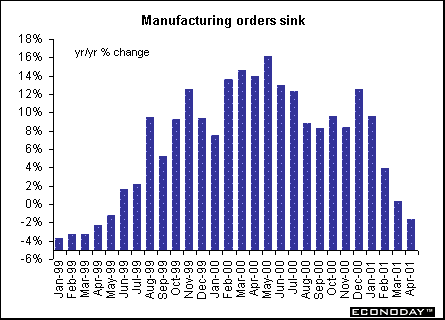
April preliminary seasonally adjusted industrial production sank 0.9 percent. Industrial production in west Germany fell 1.1 percent but rose 0.1 percent in the east. The finance ministry said these data likely would be revised downward when the revisions are released in about two weeks. The drop of April industrial production was due solely to declining output in the manufacturing sector, while output in other industrial sectors rose on the month. However, the manufacturing sector accounts for more than 85 percent of industrial output. The manufacturing sector production declined 1.5 percent. Weakness in the manufacturing sector was widespread, with three of four categories dropping. The declines were led by capital goods, down 2.9 percent, durable goods down 2.6 percent and basic goods down 1.5 percent. Only consumer goods output rose, up 1.8 percent.
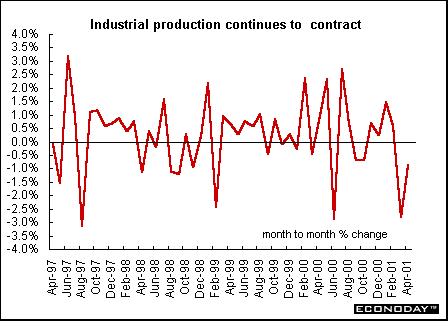
France - March seasonally and calendar adjusted real retail sales fell 1.0 percent after a 1.1 percent drop in February. First quarter retail sales were down 1.9 percent from the fourth quarter but were 2.9 percent higher on the year. Food store sales led the decline with a first quarter drop of 3.0 percent drop but were up 2.0 percent on the year. For other retailers, March sales rose 0.3 percent, limiting the first quarter decline to 0.8 percent. Compared to first quarter 2000, non-food retail sales were up 4.2 percent. Vehicle sales and repairs sector real first quarter sales surged 4.9 percent and 3.1 percent when compared with last year. Auto sales jumped 6.1 percent and 4.4 percent rise on the year.
Britain - May Halifax house prices index rose 1.5 percent and 7.3 percent when compared with last year. The rise was the fifth successive monthly increase, with prices rising by 4.2 percent over the past three months. The annual rate of increase rose to its highest level since September 2000.
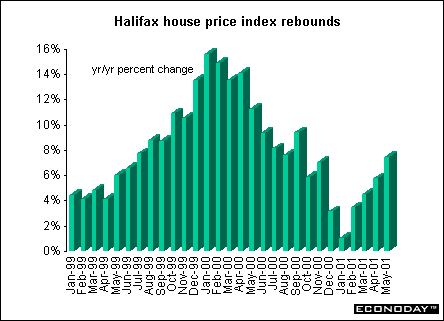
April manufacturing output fell 0.9 percent - the largest decline since August 1997 - and was unchanged from a year earlier. Most of the decline was due to a large drop in optical networking and mobile phones industry output. It fell by 22.4 percent on the month in April and 4.0 percent below levels a year earlier. Industrial output fell 0.1 percent on the month and was down 0.8 percent compared to levels a year earlier. Output of the electricity, gas and water industries rose 3.0 percent on the month, while mining and quarrying jumped 3.5 percent.
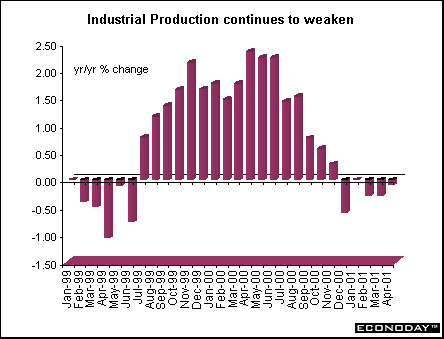
Asia
Japan - First quarter company spending on factories and equipment, excluding financial firms rose 2.5 percent when compared with last year. That is down from the fourth quarter's 7.1 percent increase. Capital spending by manufacturers was 23 percent higher in the first quarter than a year earlier. Service providers, agricultural firms and other non-manufacturers spent 5.8 percent less in the quarter from a year earlier.
April machinery orders from private firms, excluding power utilities and shipbuilders, rose 6.3 percent.
Australia - May seasonally adjusted employment declined by 4,100 jobs. That followed a record surge in part time hiring in April, which saw 40,100 total new positions added. The unemployment rate rose to 6.9 percent, the highest since September 1999. The employment drop was paced by a 14,000 decline in part time jobs. That was offset by a 9,900 rise in full time positions.
First quarter gross domestic product rose 1.2 percent and 2.1 percent when compared with last year. That follows a 0.6 percent contraction in the fourth quarter, the first slump since the 1991 recession. Pacing the growth was household spending, which rose 2.2 percent. Exports increased 0.5 percent and government spending jumped 3.2 percent. The report showed household savings as a percentage of income fell to 0.7 percent, from 2.3 percent in the previous quarter, suggesting consumers are spending more of their pay.
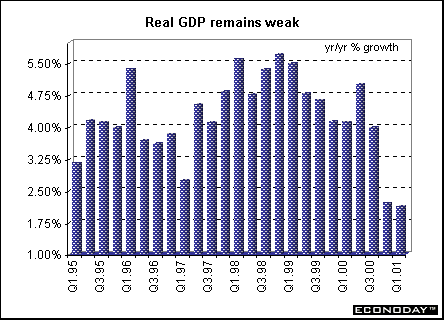
Americas
Canada - May unemployment rate remained at 7 percent. Employment edged up by an estimated 9,900. All May gains were in part-time employment, up 51,000, while full-time employment fell 41,100. The labor force rose by 8,400, with the participation rate unchanged at 66.1 percent. Manufacturing employment edged down 12,000, bringing losses so far this year to 42,000, a sharp contrast to the gain of 73,000 in the last five months of 2000. Year to date employment declines in manufacturing have been mainly in transportation equipment, computer and electronic products, and wood products. Goods producing industries were down 18,500 jobs, and the service producing sector up 28,400 jobs.



Introduction • Global Stock Market Indexes • Recap of Global Markets • Currencies • Indicator Scoreboard

The Bottom Line • Looking Ahead
|